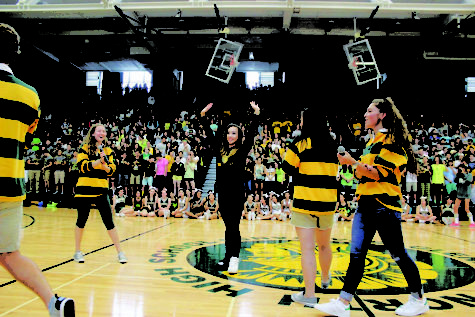Local gymnasts compete in Rio

Senior Kiana Eide was in her hotel room in Stuttgart, Germany, getting ready for dinner when teammate Natalie McGiffert received a text from her dad asking if she and her teammates knew they qualified straight from the 2016 World Championships to the Olympics in Rio. Eide said the girls did not believe him at first until they saw a Facebook post that confirmed the text.
“[The post] said all the official teams that qualified, and USA was on it,” said Eide. “I just remember dropping to the floor crying. [At the time], one of my teammates was in the shower, and she literally ran out screaming.”
Eide said they were the United States’ first rhythmic gymnastics team ever to qualify for the Olympics.
“In [the 1996 Olympics in] Atlanta, there was a rhythmic gymnastics group for USA, but that’s only because the U.S. was hosting the Olympics, so they got an automatic spot,” Eide said.
Alumnae Jennifer Rokhman (‘15) and Monica Rokhman (‘15) also qualified as part of the USA rhythmic gymnastics team.
“A day in Rio consisted of waking up at around 6:30 a.m., so we could practice getting up early for our competition day,” said Jennifer Rokhman. “… After breakfast, we would take the bus over [to] the practice gym and train for about two hours before taking the bus back to the [Olympic] Village and going straight to lunch. Right after lunch, we would all go to the recovery room and work with our physical therapist and get treatment. We would have a few hours to relax before going to [our] second practice. … When we got back to the [Olympic] Village, we would go straight to the recovery room for treatment, compression pants and the ice tub.”
On the first day of the rhythmic gymnastics Olympic competition, 14 countries competed in the women’s team all-around, each performing two group routines. The first routine was performed with five ribbons, and the second was performed with three sets of clubs and two hoops. The eight highest scoring teams continued to the second and final day of group competition.
After two performances scoring a total of 30.224 out of a possible 40 points, the United States did not qualify for the final round of eight, finishing in 14th place.
“We had one really clean routine and one routine that had a few mistakes, but we are still happy with our performance,” McGiffert said.
McGiffert, a 2016 Glenbrook North graduate, said she treated her performance in Rio just like any other competition.
“Honestly, it didn’t really hit me that we were competing at the Olympics,” said McGiffert. “For me, it was just more like a big competition that I knew was important.”
McGiffert said her favorite memory from the Olympics was staying in the Olympic Village and being surrounded by the other athletes because they did not act entitled.
Eide said she hung out with silver medal-winning diver Steele Johnson and had the opportunity to hold one of the track and field team’s gold medals.
According to Eide, none of the six girls on the USA rhythmic gymnastics team plan to train for the 2020 Olympics.
“I kind of just wanted to end it on the highest point of my career,” Eide said.
While McGiffert and teammate Alisa Kano are attending college at Loyola University Chicago, Eide said the remaining group members plan to go on the Kellogg’s Tour of Gymnastics Champions with other USA Gymnastics national team members. On the tour, which is scheduled to go from Sep. 15 to Nov. 13, the gymnasts travel to different cities around the country and perform.
“It’s kind of like a Cirque du Soleil act,” McGiffert said.
Eide said she went to Colorado to learn the choreography for the tour along with the other gymnasts, including the USA women’s artistic gymnastics team, dubbed as the Final Five.
“At first you’re, like, starstruck and just really shy to go up to them, but they’re just normal humans,” said Eide. “They’re just really sweet, and it’s really cool to just be in the same performance as them.”
Eide said it was really weird for her to come back to school after competing in the Olympics.
“I’ve never really experienced being like a normal high schooler,” said Eide. “… Not really worrying about going to practice after school is really weird. I kept asking people, ‘What do you guys do after school?’ They just said, ‘Homework.’”
McGiffert said her Olympic experience was a once-in-a-lifetime opportunity that she will look back on for the rest of her life, and Eide said the experience was “a dream come true.”
“To say that I qualified for the Olympics and I’m an Olympian is just the best thing in the world,” Eide said.

